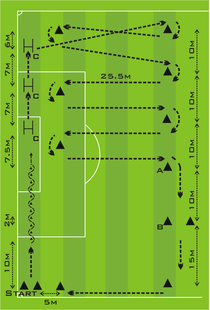Football training using football circuits - The Hoff-test
Aerobic endurance was trained utilizing a football circuit/dribbling track in youth (1) that was tested for its validity in professional players (2).
In the so-called Hoff-test (please see figure below), players had to dribble a ball (forwards and backwards) around cones.
Setup
A total area of 30 × 50 meter is needed to setup the test. The size of the test fits perfectly into one half of a regular football pitch. Therefore, two Hoff-tests can be setup and more players can be trained at the same time.
Equipment
A measurement tape (to set up the distances) and some cones are required.
Organization
If an entire football pitch is used (and therefore space for 2 Hoff-tests is available), we believe that an entire team (up to 18 players) can be trained with the Hoff-test. Players need to be separate on the test (and therefore all players can start at the same time) or start one after another with a time delay of 5-10 seconds.

- Players start dribbling at "Start" in clockwise direction.
- At "C" players need to lift the ball over a 30 cm high cone and jump over the hurdle.
- From "A" to "B" players will dribble the ball backwards.
Training protocol
The protocol duration and intensity was set to 4 minutes at 90-95% of maximal heart rate. Four sets with 3 minutes of recovery jog at 70% of maximal heart rate were performed twice for 8-10 weeks (1).
Effect of training
The players improved significantly in VO2max and as a result the football circuit/dribbling track seems to be an effective tool to train football specifically (1).
References
1. McMillan, K., et al. Physiological adaptations to soccer specific endurance
training in professional youth soccer players. Br. J. Sports. Med. 39(5): 273-277, 2005.
2. Hoff, J., et al. Soccer specific aerobic endurance training. Br. J. Sports.
Med. 36(3): 218-221, 2002.
 Footballscience.net
Footballscience.net
